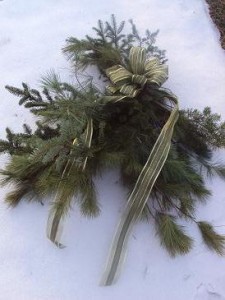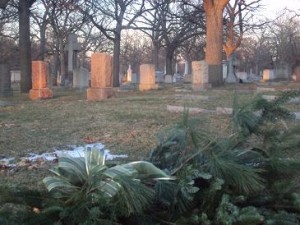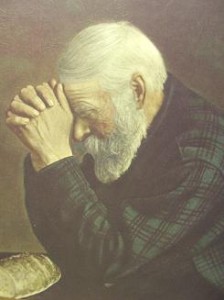I hadn’t been to the cemetery where Nate’s body is buried since November 17, nearly a month ago, and hadn’t planned on revisiting this week. But a friend made a beautiful decoration out of three kinds of evergreens, gathered together with a generous bow of green ribbon, and said, “For Nate’s grave, if you go to the cemetery any time soon.” I’d been in town visiting friends and attending Christmas functions for a few days and was within driving distance, so decided I’d go. I knew Mary Jo’s spray of greens would look nice on Nate’s grave.
I arrived late in the afternoon when the sun was taking on a red hue close to the horizon. It cast a striking peachy glow on the cemetery headstones, reminding me of Mom’s playful word for a grave yard: marble orchard. The wind was whipping at my long, black coat, and the thermometer was on its way down to six degrees. Funeral flowers had been cleared away, but Nate’s grave was still marked by the shape of relatively new sod.
Once again I felt queasy as I thought of Nate’s body lying six feet under the frozen ground. His body was frozen, too, which was difficult to ponder. I had to think away from it, reminding myself of Nate’s warm, lively existence with God.
Mary arrived, coming from a different direction of the city, and together we laid Mary Jo’s creation on Nate’s grave. The wind blew at the bow and long ribbons, trying to assert itself but failing to blow away the arrangement. We huddled together for warmth and talked about Nate.
“I still can’t believe it really happened,” Mary said, shaking her head. “It doesn’t seem real.”
I felt the same way. My mind fast-forwarded to the coming Memorial Day when our extended family traditionally meets on the spot where Mary and I were standing. None of us had known on Memorial Day, 2009, that Nate would be buried there by Memorial Day, 2010.
Did Nate have pancreatic cancer silently present in his body last May, when we all gathered at the cemetery? No doubt he did. Would it have been easier to take his diagnosis, had we known? Probably not. We would have had knowledge sooner, and the doctor would have given him a slightly better answer to the question of how much time he had left. But with death coming as a certainty, is it positive or negative to know for a longer period of time?
I thought of the Scripture verse, “O death, where is your sting?”, a rhetorical question implying that death’s sting has disappeared. (1 Corinthians 15:55) Standing in that cemetery shivering, my dominating thought was, “Nate’s death did sting!”
But that was only my selfish point of view. What about Nate’s perspective? From where he stands (or sits or dances or flies), he’s not feeling the sting. Christ Jesus took the “stinger” out of death.
Mary and I prayed together, thanking the Lord for Nate’s life and influence before we climbed into our cars and headed for the cemetery gate. The sun had gone down ten minutes before, and darkness was settling in around us. When we arrived at the exit, Rose Hill’s giant iron gates were locked tight. The sign next to them read, “Cemetery closes at 4:00 PM. Don’t get locked in.”
As we sat locked in, wondering what to do, a grounds keeper suddenly appeared with a key and a lecture. “Look at that big sign,” he said, disgust in his voice. “What does it say?” Muttering, he unlocked the gates and let us pass through, preventing a miserable night for us. The sting would have been in our freezing fingers and toes as car engines ran out of gas and heaters stopped. We were exceedingly grateful.
“He will swallow up death for all time, and the Lord God will wipe tears away from all faces. And it will be said in that day, ‘Behold, this is our God for whom we have waited that he might save us. This is the Lord for whom we have waited. Let us rejoice and be glad in his salvation.’ “ (Isaiah 25:8a,9)

